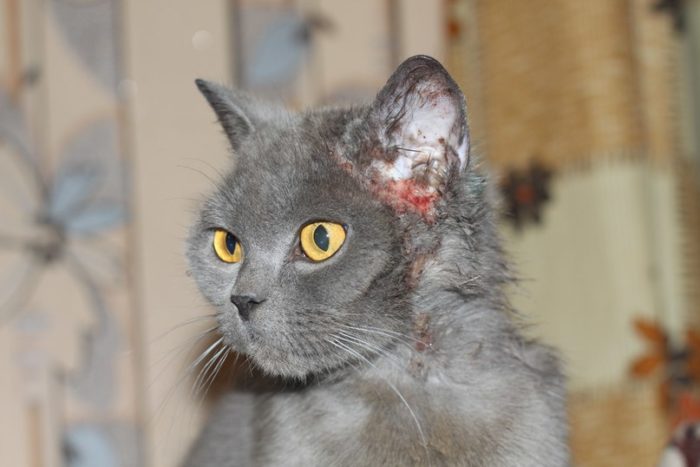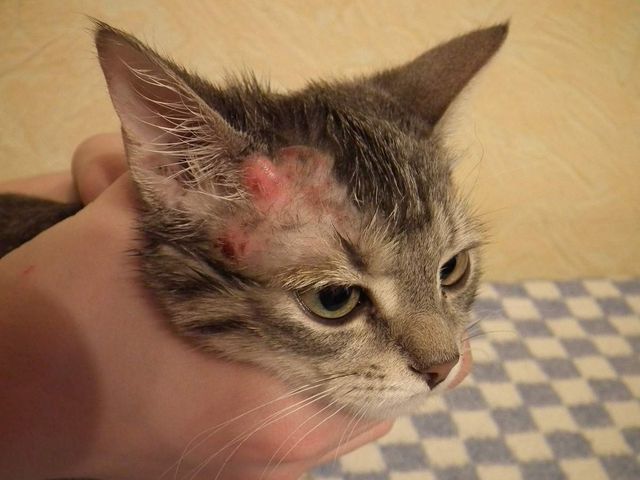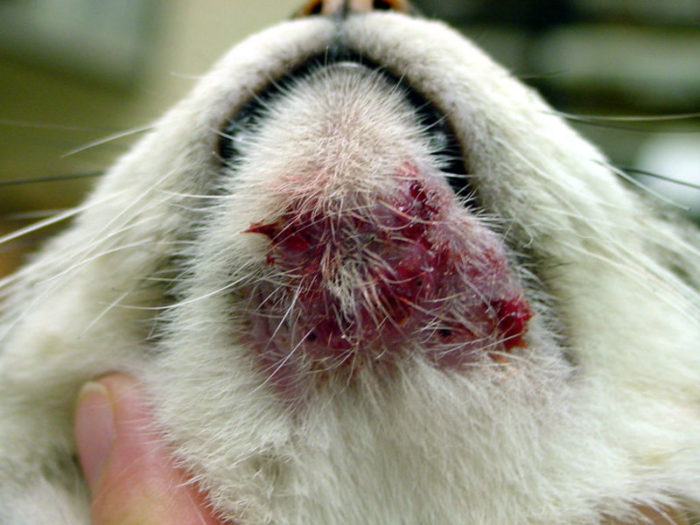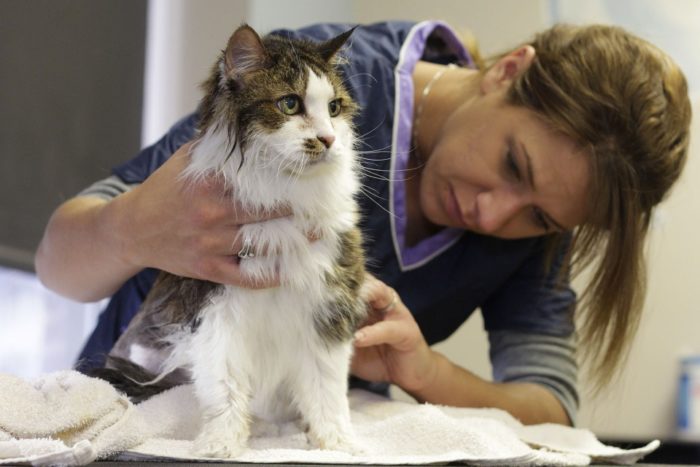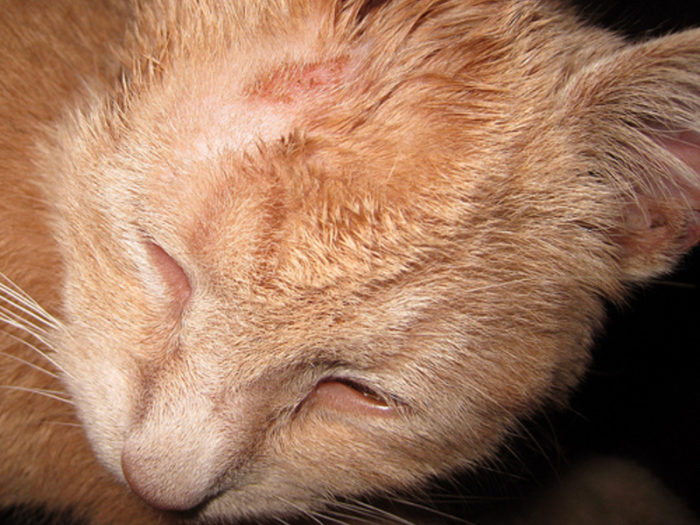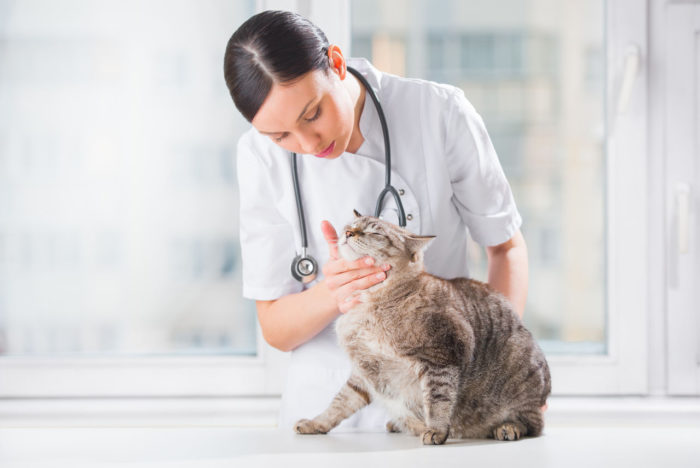Dermatitis is a skin reaction, which in most cases is a symptom, not actually a disease. Suspecting dermatitis in cats, responsible owners should immediately go to the clinic, as to help the pet independently is unlikely to succeed. What is dermatitis and why pets are so often stricken by this ailment?
Contents
General information
The term “dermatitis” hides many diseases of a variety of etiologies. But these diseases have something in common – cutaneous manifestations.
By the nature of the symptoms, dermatitis happens:
- superficial. Mild itching, slight redness or rash;
- purulent. Sores, strong scratching, clearly marked inflammation (secondary infection due to development on affected skin of pathogenic bacteria);
- wet. When the dermatitis is wetting, it looks like it is ripped off, oozing with sulphure or pus, the wool around the wound falls out.
Veterinarians refute the myth that dermatitis in cats is transmitted to humans. External manifestations of dermatitis sometimes look very scary, especially when the body of the pet has a lot of blisters, ulcers, or an eczema. But dermatitis is more a symptom, and it is possible to catch only the disease itself, and not its manifestation.
Common signs of dermatitis, regardless of the causes of the disease, are typical and easily recognizable:
- rash, scratching;
- redness, inflammation;
- puffiness, blisters, blisters, ulcers;
- extreme dryness of the skin, scales, cracks. Or vice versa, wet hairless areas;
- the skin is hot to the touch, the pet constantly feels an itch and a burning sensation.
The way dermatitis looks in a particular case depends on the individual reactions of the cat. Two pets with the same diagnosis can feel differently: one cat only itches slightly, and the second one is balding and rending the skin into the blood. By the nature of the course of the disease, this ailment is acute, subacute and chronic. If the pet is treated incorrectly, acute dermatitis can flow into a chronic form – the symptoms will disappear for a time or become less noticeable, but will manifest themselves in all its glory during the relapse. With chronic sluggish dermatitis, it is more difficult to cope, therefore even hardly noticeable dermatitis in cats on ears is an excuse to show a pet to a vet.
Types and causes of dermatitis
All species can be divided into two groups. The first group is simple dermatitis. This is the reaction of the skin to contact with something annoying (sharp mown grass, rough cloth, blanket, rubbing the collar, etc.). In representatives of most breeds, the delicate cat skin is protected by dense hair, so simple dermatitis is rare. The second group is allergic dermatitis, based on the reaction of immunity to a substance mistaken for an “enemy”. Allergies can develop on anything from new food to makeup mistakes, non-hazardous bacteria, dyes, etc. Unfortunately, cats are more often diagnosed with autoimmune dermatitis, in which skin reactions occur because of excessive activity of one’s own immunity.
Listed below are the main causes of dermatitis in pets. The information is given for reference. Please do not try to cope with the disease without the help of a veterinarian.
Fleas and other parasites
Ticks, swords and fleas are a collection of possible allergens. On the feet of parasites full of bacteria that can cause skin reactions. With insects, scales are constantly falling, they molt, salivate with bites, smear the skin with excrement, lay eggs – all this is an alien flora and alien protein, to which sensitive immunity responds with violent signs of irritation, from rash to swelling and ulcers.
Typical flea dermatitis is a strong obsessive itch at the base of the tail and / or behind the ears (where the fleas more often bite), red irritated skin, small, profuse rashes at scratching sites or throughout the body. Manifestations intensify in the warm season, but relapses are possible in winter (access and basement fleas).
Craws, soaked erosion – a stormy bright reaction to the saliva of fleas
In tick-borne dermatitis, reactions depend on the type of parasite. If the cat is sensitive to the saliva of ixodid ticks, after the bite the injection site will swell, inflame and itch. A rash appears around the bite, hair falls out. Allergy to subcutaneous mites covers the entire body – a profuse rash, strong scratching, a miliary type of reaction is possible – multiple nodular cones or point “wounds”, inflamed or not (more often brushed, feel like pitted grains to the touch). Otedektosis can also provoke dermatitis – rashes, sores on the inner surface of the auricle (where the ear mites that live and feed the otodectosis live and feed).
Internal parasites are themselves an alien body in the cat’s body, so they can cause allergies both at the initial stage of infection, and with prolonged invasion (depends on the degree of sensitivity of the pet). Worms injure mucous internal organs, secrete poisons, perish and decompose with the release of toxic substances.
In these cases, effective treatment is possible only with the absolute disposal of the cat from parasites. The only bite can cause a violent reaction, so it is important to remember and prevent – regularly treat the pet with a complex remedy from external parasites and give a tablet of worms three times a year.
Fungi, bacteria
Any fungus and any bacterium, regardless of pathogenicity, can cause dermatitis due to hypersensitivity. The symptoms are individual, from the general skin lesion to small reddened and itchy areas. Bacterial and fungal dermatitis often occur in a latent or chronic form, with blurred, unclear symptoms and relapses “without cause”.
Often, malasseous dermatitis caused by a conditionally pathogenic yeast fungus is diagnosed in cats. This kind of fungus normally does not provoke the disease and lives on the skin of pets, without causing them any harm. The sensitivity of the skin rises if the fungus begins to multiply actively, feeling suitable conditions – moisture and heat. Malassezia fungus “loves” folded skin, therefore this dermatitis is seen in cats on the nose (Persians, extremals with flat muzzles), chin, in the inguinal and interdigital area, underarms, under the tail. Symptoms are typical – redness, rash, scratching.
Only a veterinarian can decide what to treat an infection. It is important to quickly take the disease under control, otherwise local therapy will not have an effect (ointments will help to remove the itch and heal the combs, but they will appear again and again). For the destruction of bacteria, antibiotics are prescribed, for the treatment of fungal infections – special antifungal drugs. Immunostimulants will help the cat’s body to suppress the growth of the number of fungi or bacteria.
Many owners believe that this dermatitis in cats is contagious for humans, because the skin of people is also susceptible to bacterial and fungal infections. But not all kinds of fungi / bacteria that attack cats are dangerous to humans. Therefore, the degree of danger depends on whether the fungus (or bacterium) is common to cats and humans (at home it is impossible to find out, you need to pass tests). If yes, when caring for a recovering pet, it is necessary to strictly observe hygienic norms and protect the cat from communicating with young children and people with low immunity.
We remind you that dermatitis is a manifestation of the disease, therefore, even if a bacterial or fungal infection is infected from a cat, the symptoms of a person’s ailment may be quite different.
Allergens in food
Allergies can be triggered by any product, new or habitual for a cat (the so-called accumulative reaction), natural or part of the finished feed. Food dermatitis is manifested by skin rashes, itching of varying intensity, swelling. The reaction may occur immediately after the ingestion of the allergen in the gastrointestinal tract or be delayed for several hours, less often days.
In chronic, latent skin, the skin is constantly dry and peeling, the coat is brittle and dull, there is no itching. Although it is possible and wet type – wetting heavily inflamed and reddened areas of the skin, on the surface of which constantly acts as a saccharine.
The allergy is very insidious! The disease is progressing: today it is a simple “pruritus” after a chicken for lunch, and tomorrow – an attack of suffocation due to the laryngeal edema. If you suspect any allergies of any nature, the doctor should be treated immediately.
To cure atopic dermatitis, caused by a reaction to an allergen in food, is almost impossible. However, a cat can live a full and happy life, if you identify the allergen and stop its entry into the body. To do this, you need to take blood tests (it is better to immediately make an extended analysis of 24 positions) and together with a veterinarian to choose a diet. Symptoms of allergic dermatitis suppress antihistamines, hormones, sedatives, anti-inflammatory, etc. – an individual complex scheme.
Irritant substances
If the skin contacts the irritant, contact dermatitis is possible, if the organism of the pet is susceptible to irritation. As an allergen are a variety of substances – shampoos, flea remedies, household chemicals and dyes (furniture upholstery, new carpet, collar), glue, etc. The peculiarities of this kind of dermatitis is that the inflammation, as a rule, appears only at the site of skin contact with the allergen. For example, dermatitis in cats on their feet after walking on a new carpet or floor, on which there were particles of detergent. Inflammation can be superficial – a low-noticeable rash and mild itching, and deep – a bubble rash, ulcerative dermatitis with the attachment of a secondary infection, the formation of pseudo-eczema (wetting hairless area).
The effectiveness of treatment depends on how easy it is to prevent repeated contact of the pet with the allergen. Skin manifestations are eliminated with antihistamine and anti-inflammatory ointments.
Contact dermatitis is simple, i.e. not associated with allergies. Irritant can also act almost any substance – cosmetics, filler, household chemicals, glass wool, alkali and acids, own feces (for long-haired cats, if you do not give the grooming proper attention). Dermatitis of the mouth is possible in cats who like to chew plants – some house flowers are poisonous, the juice of others is not dangerous, but acrid and irritating tender mucous. To cure simple dermatitis is easier: to stop contact with the irritant, to treat the skin with an anti-inflammatory compound (ointment, solution).
When contact dermatitis of cats are often facial (ie in the muzzle) manifestations. In addition, the inflammation can capture the mouth – lips, tongue, palate, gums. This happens if the cat has licked after the stimulus has come on the coat (most often – a detergent powder, a shampoo spilled on the floor, a pinching wound healing ointment, etc.).
Injuries and microtrauma
If the cat has sensitive skin, the slightest violation of the integrity of the skin can trigger traumatic dermatitis – rubs the collar, the cat’s paws the mowed grass, the paw pads rub against the coarse pile of the carpet, the rough seams of the treads rub the skin in places of bends, etc. Symptoms are typical – inflammation, redness, rash. Ulcers and blisters appear rarely, only in the most severe cases and with prolonged exposure to the skin of a mechanical factor. The area of injury is limited by the place of injury.
Sensitive skin reacts with inflammation and more serious injuries – electric shock, surgical suture (any pressure, friction). If the injury is easy, the pet can be helped at home – anti-inflammatory treatment of the affected area, cessation of mechanical skin irritation.
Seborrhea
This ailment in itself seldom causes concern to owners – think, dandruff sypetsya! But dandruff is a signal that the work of the sebaceous glands is broken. Dry scales and moist lumps irritate the skin and create suitable conditions for the development of pathogenic flora. If the skin of the pet is sensitive or if the pet has suffered severe stress (illness, nervous shock), banal seborrhea passes into seborrheic dermatitis – chronic itching, reddening of the skin throughout the body (especially in places of anatomical bends, in folds), a bad unpleasant smell appears, the coat sticks together icicles or becomes brittle, dull and dry. Without treatment, complete or partial (behind the ears, on the croup, at the tail, on the hips) baldness is possible.
To get rid of seborrheic dermatitis, it is necessary to restore the work of the sebaceous glands. Special shampoos and solutions will help (only after consulting a doctor, because an incorrectly selected shampoo will greatly worsen the situation). The introduction of vitamin A and fatty acids into the diet (omega 3 and omega 6) helps.
Other factors that provoke dermatitis:
- reaction to drugs in any form;
- diseases of internal organs and systems (kidney, liver, GIT, diabetes, etc.);
- hormonal disorders;
- chronic stressful condition;
- inadequate care, poor living conditions, non-compliance with hygiene.
There are a lot of reasons! And in each case only the veterinarian must decide how to treat the consequences and the underlying disease. Remember that local treatment will not bring lasting effect. First aid is only to stop the effect on the body of an irritant substance, if known. You can give the pet a Stop-itch, carefully claw your nails and put on a lightweight blanket to prevent infectious infection. But something to smear sores is not necessary – this will complicate the diagnosis.
Treatment of dermatitis is always complex: eliminate the symptoms (remove itching and swelling), overcome or prevent secondary infection (antibiotics topically or in tablets) and take control of the underlying disease. Please contact the veterinarian on time: Dermatitis is difficult to treat, often and quickly passes into a chronic form and greatly undermines the immunity of the pet, making it vulnerable to various types of infections.









